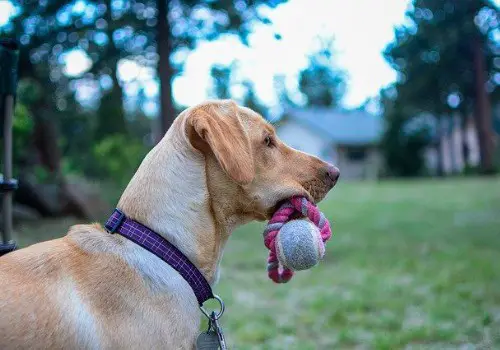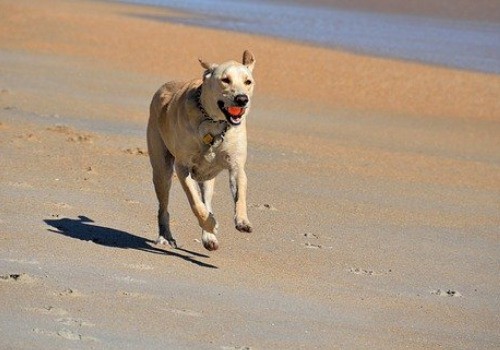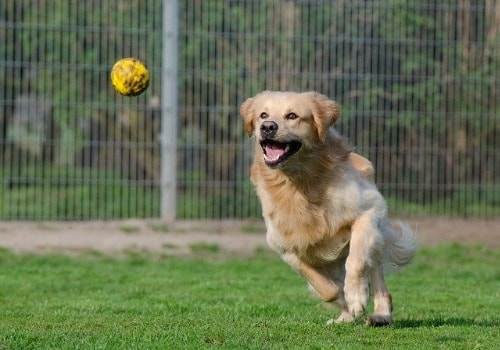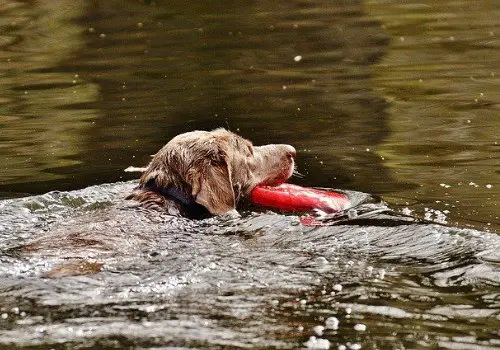Is there anything your dog loves more than a game of fetch?
All right, dinner time, maybe. Table scraps, sure. Belly rubs… yeah, we’ll give you that one.
But fetch is definitely up there! As far as active playtime goes, fetch is about as good as it gets for your dog.
Maybe it’s the wind through his fur as he accelerates to top speed. Perhaps it’s the adrenaline rush from chasing and catching his target with unbelievable precision.
Or maybe it’s just the joy of spending some quality time with his favorite person.
Whatever the reason, fetch seems to bring out the best in your pup. Let’s explore the art and science of fetch and learn just why this game is such an important part of canine life.
It Runs in the Family

Fetching seems to be ingrained in a dog’s biology.
Throw something for your dog and he’ll immediately know what to do: chase it, catch it and bring it back.
And the root of this behavior can be found tens of thousands of years ago, before the domestic dog diverged from its wolf brethren.
Prey Carrying in Wild Wolves
Canines had been around for around 20 million years, when they diverged from felines. The first wolves split from other canines between 2 and 3 million years ago.
And the gray wolf — the animal we think of as the archetypal wolf — first appeared around 1 million years ago.
We can’t know for sure how these early wolves behaved, but we can make pretty good guesses based on the behavior of modern wolves.
They likely lived and hunted in packs as they do now. Over hundreds of thousands of years, they honed their tracking and hunting skills, becoming the formidable predators we know them as.
And in all likelihood, they exhibited the same prey carrying behavior that modern wolves do.
Prey carrying refers to the act of carrying successful kills back to the rest of the wolf pack in order to share the food. This cooperative behavior enables all members of the pack to eat, even if they’re too young, old or weak to participate in the hunt.

Sound familiar? That’s because your dog does it too.
Of all the wolf instincts that have been passed down to domestic dogs, the prey carrying instinct is one of the strongest. You can see it in the enthusiasm with which your dog chases his tennis ball, catches it and brings it back to his pack — that is, to you.
Interspecies Cooperation
The human and canine worlds collided between 10,000 and 40,000 years ago. This domestication event changed the lives of both species forever.
It’s thought that as humans became more adept hunters, wolves learned to follow them and scavenge the leftovers. Friendlier wolves who were more tolerant of humans got to eat more and subsequently bred more as well.
This led to the dominance of friendly genes in the wolf species, and humans took notice to the more sociable specimens. As the two species gained each other’s trust, they began to help each other out.
Humans would throw food scraps to friendly wolves and help care for sick or injured ones.
In turn, wolves would alert humans to intruders on their shared territory. And some scientists believe that wolves would help humans carry large kills back to their homes.
It’s this last point that suggests the strong role humans played in developing dogs’ inclination to fetch.
Wolves that helped humans carry carcasses home would no doubt be rewarded for their efforts with extra food and protection. They’d thus be more fit to breed, passing those cooperative, sociable “fetching” genes on to the next generation.
And eventually, the difference between these friendly wolves and their more wild counterparts became so pronounced that the species split into two: the gray wolf and the domestic dog.
The Tail End of Domestication

After domestication, humans and dogs lived together as no two species had done before.
And as our knowledge of breeding grew and other technological advancements took place, we began shaping dogs in yet more unprecedented ways.
Clearly, dogs were useful to us in many ways. They protected us from predators and assisted us with detecting, tracking, catching and retrieving prey.
Dogs that were better at these tasks bred more, resulting in the development of different breeds. Humans took notice of this and began intentionally breeding dogs with similar characteristics, strengthening those genes and creating specialized dogs.
These dogs possessed the features and drives necessary for carrying out specific tasks. The most common tasks were hunting and retrieving, and we can see evidence of this in many modern dog breeds.
For instance, the Labrador Retriever dates back to at least the 1830s, when it was first described as an excellent retriever of waterfowl.
Its soft mouth and disinclination to shake prevented the prey it carried from being damaged. And those prey carrying instincts from thousands of years ago persisted, making the Lab a natural at its job.
These days, most retrieving breeds aren’t working dogs anymore. They’re beloved family pets who don’t need to do a job to be a member of the family.
But throw that tennis ball and those retrieving genes activate instantaneously. That ball might as well be a shot duck, falling to the ground and ready to be carried back home.
Beyond Instinct

So the instinct to fetch clearly has strong roots in canine biology — that much is apparent.
But there’s more to your dog’s love of fetch than pure evolution.
As any dog owner knows, animal emotions run deep. When your dog feels something, he feels it with his whole heart, mind and body.
You can see it on his face and in his behavior. And there’s no better evidence of this than when it’s time to play fetch.
The Satisfaction of Success
Whether you play to win or just to have fun, there’s no denying that doing well at something feels good.
Hitting a home run, getting a perfect score in a competition and claiming victory in a game of Monopoly all satisfy our drive to succeed. That’s because of the risk involved in these actions: there’s a chance you might fail, so there’s an element of nervousness present.
But when you succeed, that nervousness vanishes, and your brain becomes flooded with hormones like dopamine and testosterone. These hormones cause a surge in energy and make you feel like you can do anything.
They also ignite your desire to keep going for another round, keeping up your winning streak and perpetuating the production of those feel-good hormones.
It’s the same with dogs too. When a dog succeeds at something, those same hormones are produced, which is why your dog always excitably begs for you to throw that ball again as soon as he drops it at your feet.
Since dogs are so naturally gifted at retrieving objects, their satisfaction hormones skyrocket when they play fetch. It can feel so good as to be almost unbearable — hence your inability to calm your dog down when playtime is imminent.
Fetching Breeds Familiarity

There’s also a very simple reason why your dog loves fetch so much: because he loves you.
Maybe it’s not so much about the ball as it is about the person throwing it. Sure, it’s fun to chase and catch the ball… but it’s even better seeing your smiling face when he brings it back to you.
Dogs are excellent at picking up on human emotions. They comfort you when you’re sad and bounce around the house with you when you’re excited.
So when you lovingly beckon your dog back once he’s caught his ball, your joy becomes contagious. Your dog wants to keep the good vibes going, so he keeps fetching that ball.
That quality time with your beloved dog doesn’t just fill you with joy — it fills him with joy too.
It reinforces your bond and just plain feels good. After all, spending time with loved ones always does, regardless of species.
